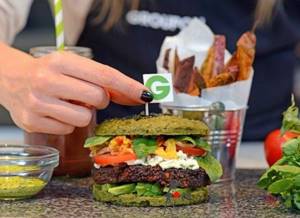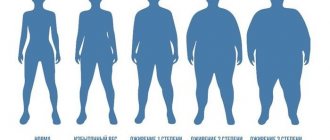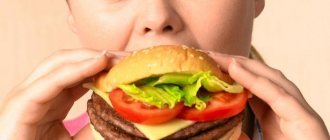Fast Food is a term that translated from English means “quick food”. Fast food has become a part of modern life, and its absence is unimaginable. Many people buy ready-made food every day to snack on the go. Advertising of these products and artificial additives that improve taste and are addictive have a strong influence on people's consciousness. In addition, such food is accessible and beautifully presented - new establishments, restaurants, cafes, kiosks and eateries are opening everywhere, offering a quick and inexpensive snack.
Below we will look in more detail at what fast food is; initially, such food included sandwiches that workers took with them to work. Due to lack of time, they quickly had a snack and continued working again. Later, sandwiches turned into hamburgers and became more delicious. Some busy people still use fast food as an on-the-job snack. Not everyone thinks about the benefits, or rather, the dangers of fast food. An addiction to such food can develop due to lack of time. Many people stop by for another hamburger after work, turning it into a habit.
Some interesting statistics
Let's talk a little about numbers.
According to statistics, every second Moscow resident consumes fast food at least 2 times a week, and the average bill is 650 rubles.
From the above we can conclude that the monthly market volume IN MOSCOW ONLY is equal to: (6.15 million people * 650 rubles) * 8 visits per month = 31,980,000,000 rubles.
Almost 32 BILLION, friends, per month! And this is only in Moscow.
Just imagine the volume of fast food sales per year IN THE WORLD! This is a colossal number.
Here are some more fascinating statistics for the USA (the country that is the leader in fast food consumption in the world), expressed in infographics:
A huge, multi-billion dollar industry that is only growing year after year, despite all the reliable research on the dangers of this food.
McDonald's is the MOST POPULAR fast food chain in the world.
Mac has more than 36 thousand restaurants worldwide and sales of $35.4 billion a year.
There are hundreds of fast food brands, and this article is not enough for me to list them all, and in general, that’s not what we’re talking about.
It would seem, what is the harm in this diet, because it is all made from vegetables, bread, and meat...
Yes, it should be so, but are you sure it's true?
Emergence of the street food industry
The first company to start producing fast food was White Castle. This happened in 1921 in Kansas, USA. It was they who began to serve their customers hamburgers, which were still completely unfamiliar to ordinary Americans. The low price, as well as the excellent taste, only pleased the guests of the diner. After all, everyone could afford a delicious lunch for five cents. At the end of the 40s, White Castle began to acquire its first competitors. One of them becomes a then-unknown woman who conquered the whole world. But “White Castle” currently exists only in the United States.
What is Fast Food
Fast food is fast food.
And, it would seem, everything is correct, because there are no harmful products in there, or at least they shouldn’t be there.
Are you sure, friends?
It’s one thing if you took wholemeal flour, baked buns from it in your oven, put freshly picked lettuce, cucumbers, tomatoes there, made a cutlet from homemade meat, prepared a sauce from egg yolks, sour cream, olive oil, and then ate it.
In this case, yes, there really is no harm, and if there is, it is minimal.
But it was not for nothing that I told you at the beginning of the article about the numbers and sales volumes for this industry.
If something happens in this world, then you always need to ask the question, who benefits from it ?
And this is beneficial, first of all, to fast food sellers and manufacturers.
Manufacturers of semi-finished products are interested in the maximum marginality of their goods, and sellers are interested in the marginality of their final goods.
The most fun is when the manufacturer and seller are within the same company.
Manufacturers are trying to create semi-finished products (in the case of burgers: sauces, buns, cutlets) with maximum margins for themselves!
How to do it? There are two ways:
- Increase the price of semi-finished products.
- Reduce product quality.
There is no third.
If we increase the price of semi-finished products, we will not win the tender from the retail chain and will be left without orders...
All that remains is to reduce the quality of the goods produced, then you can leave a low price, but maintain a good margin, because production becomes cheap.
You can make a cutlet from pure beef meat, for example, Black Angus, then the price of such a cutlet will be, conditionally, 400 rubles (for example, including the cost of raw materials, electricity, oil, labor hours, etc.).
This means that these cutlets must be sold at a price of more than 400 rubles.
Add here the cost of producing buns, sauces, tomatoes, cucumbers, lettuce, etc.
Get a good 600-700 rubles minimum, and this is the COST OF THE BURGER!
And we still need to earn something from sales, so we add at least another 15-20% (or even more!) to the cost.
We get 800-850 rubles for a quality burger.
I think you understand that all prices are conditional, but reflect the very essence.
Another problem appears, SALES OF FINISHED PRODUCTS.
But there are very few retail chains that strive purely for quality and do not take into account price.
Because, roughly speaking, most people are not willing to pay more than 300 rubles for a burger (and this, as we remember, is less than the cost of our cutlet), it is in this price segment that the main sales occur.
We have low demand, which means there are few sales and low earnings.
Therefore, most fast food chains strive to reduce the price of the product by reducing quality.
Therefore, in these three hundred rubles he needs to meet the price of the cutlet, and the price of buns, and the price of everything else, and even taking into account the fact that 30-40 percent (not 15-20, as a rule) need to be increased in order to earn money.
So in the end we have what we have.
Cutlets made from genetically modified products.
Loaves made from cheap flour, vacuum sealed to last longer.
Frozen vegetables. The cheapest sauces contain huge amounts of low-density lipoproteins (bad cholesterol).
And much more…
The cost of such a burger is 120-180 rubles, but it sells for 300. The margins are crazy, there are a huge number of sales, the marketing machine is running.
I would also like to say something about marketing.
After all, it was McDonald's that introduced mandatory rules that enormously increase sales.
Here are some of them:
- Funny clown - Ronald McDonald, balloons, bright colors, Happy Meal - what is it made for? "For children!" - someone will answer. Yes, my friends, but not for children, but for parents who are ready to give their children anything to make them happy. Mac plays on people's feelings, maternal instinct, attracting children, who, in turn, drag their parents with their wallets to such establishments.
- There are practically no attractive waitresses working in Mak. Moreover, waitresses are forbidden to wear makeup. Why? So as not to scare away married couples. A man will not stare at the waitress, and an enraged wife will not rather drag her husband with his wallet from McDonald's so that he does not look at the pretty person.
- Always offer upsells to clients. Upselling is an additional sale. Have you ever noticed why they always offer you a pie or ask, “Anything else?” at the end of your order? It was this phrase that was able to enormously increase sales in Mac, according to research from the marketing department.
In general, there are many more such rules. I have no purpose to list them all, I’m just talking about all this so that you understand that the goal of Mac, and indeed any fast food restaurant, is to increase profits !
And in war, even in a war FOR THE CLIENT, as they say, all means are good.
Reducing quality for a better price, aggressive marketing, playing on people's feelings and much more.
Expert opinion
Egorova Natalya Sergeevna Dietitian, Nizhny Novgorod
Fast food is a real scourge of our time. Everyone's favorite burgers and cola have the same amount of calories per meal as an average person needs per day. As a result, the body stores into fat what it did not manage to use during the day.
Complications of obesity, in addition to the aesthetic component, are hypertension, other heart complications, atherosclerosis, excessive sweating, slow metabolism, skin problems, etc.
The recent trend of stores with so-called healthy fast food appearing in many cities is encouraging. Such points organize the delivery of healthy, freshly prepared food, packaged in portions for the whole day. You can choose salad, turkey cutlet, cheesecakes and other fresh dishes.
Traditional fast food, in addition to various burgers and hot dogs, also includes chips, seasoned croutons, various “quick” soups and noodles. People like this food primarily for its accessibility (no cooking required) and bright, spicy taste. It's no secret that manufacturers add wild amounts of flavoring additives to chips, hamburgers and other food waste, which have a detrimental effect on the digestive system and can cause cancer.
Why is fast food harmful?
Let's list why fast food is harmful and what consequences of fast food you need to know.
I will only tell you the most basic problems, but I want you to understand that there are many more problems arising from these basic ones!
Problem #1: Excess calories and obesity
You'll feel like you're eating a large piece of food when you put it on your plate, and you'll likely not want to eat for a long time. What's harmful here?
Logically, it seems like this is how it should be.
But in reality it turns out completely differently.
A burger, due to its composition, forces you to eat more (due to sugar, salt, flavor enhancers, aroma, appetite, etc.).
I have prepared an interesting infographic for you so that you can compare how many calories are in healthy food and fast food:

The conclusions are obvious.
And therefore, we have the following problem.
Problem #2: You eat more than you initially want
This problem is related to substances found in fast food products.
Flour products, including burger buns, are products with a high glycemic index! Those. products, after entering the body, we experience a large AMOUNT of sugar in the blood.
By the way, flour products contain a huge amount of sugar and salt, which we will talk about later.
Coca Cola, which contains huge amounts of SUGAR, pumps your body with glucose, which causes a surge of insulin, a transport hormone that transports glucose and other substances to places of use.
Insulin is an antagonist of somatotropin (growth hormone), it stops the effect of the latter and stops fat burning.
And, as we know, on a diet the first thing you need to limit is SUGAR. Sugar is a kind of appetite enhancer.
Sugar causes an increase in the level of DOPAMINE (the hormone of joy), and this leads to the fact that you start eating more.
Sugar also affects the level of ghrelin in the blood (the hunger hormone). Hunger remains in place, and fat burning is stopped due to the large amount of sugar and insulin production.
Add, for example, a little sugar to cottage cheese with sour cream, and you will notice how you ate a much larger portion than you planned.
The next thing that stimulates you to eat more is FLAVORS and TASTE ENHANCERS!
All of these substances also encourage you to eat more food. And they are found in burger buns, “meat” and sauces.
Next is SALT, which is found in large quantities in processed foods (soy burger meat) and in sauces. It stimulates the appetite, and salt leads to fluid retention, which causes swelling, especially in the morning.
We can eat much more salty foods.
That's why you can devour two Baconizers from Burger King or a couple of Big Tasties from Mac at once. Try eating the same amount of cottage cheese without everything or buckwheat. Not sure it's going to happen.
Problem #3: Cardiovascular disease
Smoked (bacon), fried (McDuck soy meat) and other similar foods increase the risk of cardiovascular disease.
Why?
For several reasons.
Firstly, these products contain a huge amount of low-density lipoproteins. Someday, I will tell you about this in detail.
Briefly, cholesterol, to put it in rustic terms, is “good” and “bad.”
What is the difference?
Cholesterol is used to transport fat in our blood.
These are peculiar containers for transporting fat molecules .
So, if a moderate amount of fat enters the body, then the body transports it in dense, small containers of small volume.
Everything goes well. Such containers easily pass through all the branches of the vessels, so the body does not create any additional stress.
These containers are called HIGH DENSITY LIPOPROTEIDS, and in other words, GOOD CHOLESTEROL.
The body needs it because... Helps transport fat safely to places of use.
But what happens when the body begins to fail to cope with the transport of incoming fat into the body?
This can happen when we eat too much fatty foods.
In such a situation, the body begins to produce larger containers - LOW DENSITY LIPOPROTEIDS.
You can transport more fat in such containers at a time, but bad luck, when these containers become more numerous, congestion begins to form in the places where the vessels branch, and in other words, CHOLESTEROL PLACLES.
When these cholesterol plaques clog the branches, the blood begins to look for another path, which entails an increase in pressure, numbness of the limbs, and ultimately HEART ATTACKS and STROKES.
This is called atherosclerosis.
Heart problems are the most common cause of death in the 21st century. Out of 4 people, three die from heart problems, which are caused by many factors (overeating, poor nutrition, lack of physical activity, genetic predisposition, etc.).
If we eat fast food all the time, then this multiplies our chances of killing our blood vessels by clogging them with fat.
Do you think this is the only problem from consuming fried soy meat and smoked meats?
Well, of course not)
Second, this is OIL, or rather, margarine, on which all these semi-finished products are fried.
And if in Mak and other large fast food chains they somehow monitor the number of frying cycles per pot of oil, then in small eateries - yeah, good luck)
If you fry the cutlets in oil once, then nothing particularly bad will happen, but if you fry them twice, then the amount of carcinogens in the meat doubles.
After the fifth frying cycle, real poison is cooked in the cauldron, which leads to heart problems, the risk of cancer, stomach ulcers and other unpleasant moments.
This kind of oil with a changed structure is called trans fat.
I'm not even talking about the quality of oil in such establishments. Are you sure that expensive, high-quality, purified oil is used for frying?)
I'm not. Looking at the volume of production of burgers and other fast food products, I would like to hope that they are fried at least not with diluted waste engine fuel) And thanks to the chef)
But seriously, I think you understand the scale of the tragedy.
Problem No. 4: Development of type 2 diabetes, and then type 1
As we said above, fast food causes a sharp increase in the amount of glucose (sugar) in the blood.
Add to this food sugary drinks, such as cola or sugary cocktails, and consumption of all this at least a couple of times a week, and we have kilograms of sugar consumed monthly.
In a normal case, when a person does not abuse sugar and carbohydrates with a high glycemic index, the body responds to the entry of glucose into the blood by stimulating the pancreas to produce insulin.
If you often (at least a couple of times a week) eat fast food, then your pancreas works under heavy load - it is forced to pump insulin in large quantities.
Over time, it begins to fail to cope with regular excessive load and breaks down. Those. In response to the received glucose, insulin is produced in insufficient quantities.
Blood sugar levels rise and we develop type 2 diabetes.
If the situation with the consumption of carbohydrate foods and high sugar levels continues, then the pancreas practically fails, and we become insulin dependent, because. forced to inject themselves with insulin to lower their blood sugar levels.
It always seems that the problem does not concern you if you are young, for example, but it is better to be warned than to realize it too late.
There is no need to take a consumerist approach to your health.
Other problems…
I will not list all the problems here, as I said, because... there are a huge number of them.
Most of them come from the above problems, for example:
- Depression (hormonal imbalance due to dopamine surges due to sugar, which is relieved by stress hormones).
- Decreased testosterone levels in the blood (increased fat mass, decreased sensitivity to insulin, a shift in the body's balance point and an increase in estrogen levels in the blood).
- Deterioration in the quality of sperm (the body ceases to see the expediency of reproduction for itself, because it has health problems, and weak offspring mean a deterioration of the subsequent genome).
- Caries (the bacteria that cause caries feed on sugar, because it is an excellent nutrient medium, so fast food, which is literally stuffed with sugar, causes dental problems).
And much more…
Disadvantage one: high calorie content
The body tries to store excess calories as reserves, and they turn into excess fat tissue. A city dweller's need for fat rarely exceeds 50 g per day - that's about 400 kcal
.
This is the amount of fat contained in three large sandwiches with butter, several slices of lard or a large sausage. How many of them will you eat if you decide to have a quick snack? A regular burger weighs 114 g and contains 250 kcal, of which 80 are fat. For comparison, a sandwich made from a slice of white bread with fatty amateur sausage has 60 kcal less. A larger fast food sandwich, with three layers of bun and two patties weighing 214 grams, supplies the body with more than a quarter of the daily calories
- 540 kcal, of which 260 come from fat.
A 4-cheese pizza weighing 480 g has 1124 kcal. A small portion of cabbage and carrot salad with mayonnaise dressing contains 284 kcal, 70 g of French fries contains 276 kcal, and a glass of chocolate cocktail contains 400 kcal – the daily norm
.
Conclusions about the dangers of fast food
Today we have discussed a very important topic, in my opinion, because... this shapes our further eating behavior, and therefore improves our quality of life.
In general, if you take the product itself, let’s say a burger, then consuming it, prepared with your own hands, on good products at home, most likely will not cause any health problems, especially if consumed a couple of times a month.
But if you consume store-bought, relatively cheap fast food on an ongoing basis, you will definitely end up with serious health problems.
As always, there is medicine in a spoon, poison in a cup.
You can eat everything, but not everyone and in different quantities.
Types of fast food products

All fast food can be divided into several categories. It depends on where it is produced, from what products, and what its shelf life is. Such foods include:
- mashed potatoes, noodles and bagged soups;
- chips, crackers, popcorn;
- pizza, hot dogs, pies and belyashi, shawarma;
- French fries, hamburgers and cheeseburgers.
When people ask what fast food is, they usually mean food that you can eat for lunch or snack at the nearest cafe. Semi-finished products do not fall into this category: frozen dumplings, cutlets, sausages, soup sets consisting of chopped vegetables. Although their benefits are also questionable, because nutritionists recommend cooking only from fresh ingredients at home.

Disadvantage six: portions are too large
Standard portions in fast food establishments are unreasonably large
. For example, a large pizza is more than half of an adult's daily calorie intake, a glass of cola is a daily dose of sugar, and just one hot dog is almost twice the safe amount of processed meat per day. And in addition, visitors are offered “double”, “king” and “premium” portions - in which there is even more volume and calories, and a lower price. This marketing ploy causes consumers to eat much more than they intended.
How to snack properly

A person snacks on average three times a day. This can happen at home, on the go or at work. Snacking is beneficial if you follow a few rules:
- Drink a glass of water before meals.
- Pay attention to the calorie content of the product.
- You should not read, watch TV, or study information on the Internet while eating.
- You need to eat slowly, chewing thoroughly.
- Two snacks per day are enough.
Instead of fast food for a snack, you can use:
- bananas – tasty, healthy, mood-enhancing;
- baked potatoes, rich in potassium, phosphorus, promoting metabolism;
- dark chocolate is a product that satisfies hunger well;
- almonds, tonic, uplifting.
If you organize snacks correctly - not with fast food, but with healthy products, then you can maintain your health, performance, and mood.
Reason number 3: fast food has too much salt
Table salt in moderation will not do anything bad to your body, but its excess can affect the functioning of the kidneys and heart. Fast food dishes are generally characterized by a high content of calories, fat, sugar and salt. So, for example, eating a lunch of a salad, a burger, a portion of potatoes and one cocktail will give you about half the maximum safe daily allowance of salt. If you are tempted by such a menu twice, this is already a risk to your health.
The fast food menu is full of fast carbohydrates, which the body instantly converts into fat. If you want to eat sandwiches and potatoes, then don’t complain that you can’t fit into your favorite jeans. The prohibited list also includes sugar and honey, alcoholic beverages and fatty sauces - ketchup and mayonnaise. By the way, fast food also stimulates the formation of cellulite. Now we definitely won't eat it.
Doctors' opinion
The principle of fast food, according to the gastroenterologist, cannot be the cause of gastrointestinal disorders. Doctors point to the indirect influence of fast food on human health, that is, fast food is considered a provocateur of the development of diseases and their exacerbations.
Considering the issues of fast food through the prism of the benefits and harms of fast food, it should be noted that in case of emergency (severe hunger), doctors advise not to neglect fast food and have a snack. Otherwise, liver and gallbladder diseases may occur.
How much sugar is in popular drinks?
| Beverages | Portion, g | Sugar, teaspoons | Calories from sugar |
| Cola, glass | 284 | 5,25 | 123 |
| Lemon soda, glass | 284 | 5 | 120 |
| Orange drink with juice, glass | 284 | 5,5 | 132 |
| Hot chocolate | 340 | 5,3 | 128 |
| Vanilla cocktail | 300 | 9 | 216 |











